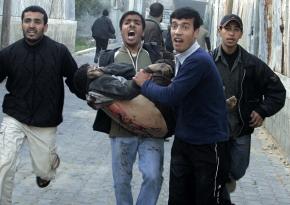Massacre at a Gaza school
reports on the single bloodiest attack in Israel's war on Gaza.
AN ISRAELI attack on a United Nations school where hundreds of desperate Gazans had taken refuge from the 11-day-old onslaught has dramatized the barbarism of the latest stage of Israel's war on Palestinians.
At least 40 people were killed and as many injured in the January 6 shelling of the school, which was filled with men, women and children who had fled their homes in fear, and who thought they had found a safe refuge from the violence.
"Most of those killed were in the school playground and in the street, and the dead and injured lay in pools of blood," reported Britain's Guardian newspaper. "Pictures on Palestinian TV showed walls heavily marked by shrapnel and bloodstains, and shoes and shredded clothes scattered on the ground."
Earlier in the day, an entire family, including seven children between the ages of 1 and 12, was killed in an air strike on their home in Gaza City. The death toll among Palestinians surged to more than 600 as Israeli operations escalated early in the week.

The Israel Defense Forces (IDF) admitted it attacked the school, which UN officials had identified to the invaders as a building where people from the surrounding Jabaliya refugee camp had been encouraged to take shelter.
The IDF claimed its forces were responding to mortar fire from Palestinian fighters inside the school compound. "They shot back to save their own lives," said Israeli military spokesman Ilan Tal. Israeli Foreign Minister Tzipi Livni insisted that Hamas, the Islamist party that won elections for the Palestinian National Assembly three years ago, was "hiding amongst civilians."
But John Ging, head of the UN Palestinian refugee agency which runs the school, said, "So far, we've not had violations by militants of our facilities."
THIS ISN'T the first time Israel has served up the same excuse--nor the first time the U.S. media repeated it ad nauseum. Israeli officials claim that Hamas has "cynically and callously" put civilians at risk by positioning fighters among the population at large.
No one in a position of power in Israel or the U.S. cares to admit it, but Hamas is popular in Gaza. The idea that a core of hardened Hamas fighters willing to defend themselves against Israel's onslaught can be identified separate from the population as a whole is preposterous.
Moreover, Gaza is one of the most densely populated places in the world, with 1.5 million people packed into a 140-square-mile area and subjected to worsening conditions that have led residents to describe it as the world's largest open-air prison. These close quarters made it "entirely inevitable if artillery shells landed in that area [that] there would be a high number of casualties," the UN's Ging said.
And despite this, no weapon or tactic has been too savage for Israel to use in its assault. When the Israeli military targeted a senior Hamas leader, Nizar Rayyan, it used a 2,000-pound bomb that killed him and 15 members of his family, and obliterated their home and surrounding buildings.
When the ground offensive began, Israeli forces used white phosphorous shells, allegedly as a smokescreen to obscure its troop movements, though this chemical weapon causes horrific burns if it comes in contact with a person's skin.
The U.S. media report on the conflict as if Israeli and Palestinian military forces are evenly matched. Yet the casualties are horrifically one-sided. When four Israeli soldiers were killed by shells from their own tanks on January 6, the toll from these "friendly fire" incidents nearly equaled the total number dead from Palestinian resistance to the ground invasion and Palestinian rockets fired from Gaza at southern Israel.
These rocket attacks are the stated pretext for Israel's offensive against Gaza, and U.S. and Israeli officials are united in blaming Palestinians for breaking a six-month truce by firing them.
But it was Israel that broke the truce with an attack on November 5 that killed six Palestinians. Palestinian fighters resumed firing rockets as a response, and though they have reached further into Israel than previously, the rockets haven't inflicted even a tiny amount of the carnage that Israel has with its U.S.-supplied fighter planes, attack helicopters and advanced armaments.
Yet almost none of this penetrates the mainstream press in the U.S. In its latest editorial, the New York Times urged Israel to "end this conflict as soon as possible"--but not out of outrage at the human suffering in Gaza.
On the contrary, the editorial repeated every false claim and distortion--that Palestinian rockets were "terrorizing" the people of southern Israel; that Hamas is to blame for breaking the truce; even that Hamas, a predominantly Sunni organization, is a mere "proxy of Iran" and its Shia-led government.
Instead, the Times recommends a settlement out of fear that Israel is pursuing its war past a "point of diminishing returns."
So at what number of Palestinians maimed and murdered did the "returns" start to diminish? Hundreds? Thousands?
Israel has been able to rely on the U.S. political and media establishment--Democrats and Republicans, liberals and conservatives--taking up its every justification for devastating Gaza. It is up to opponents of war and supporters of the rights of Palestinians to live free from Israel's terror to expose the lies and protest these latest war crimes.


